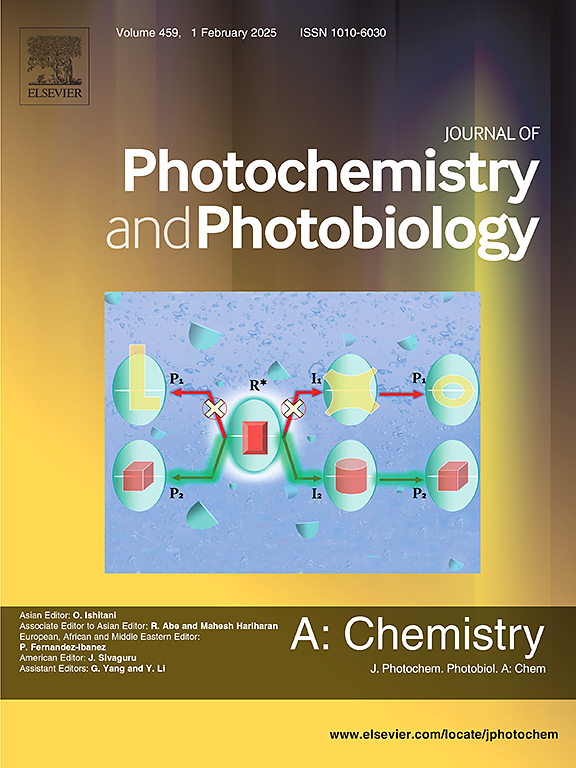高尔基定位近红外荧光探针识别半胱氨酸
IF 4.7
3区 化学
Q2 CHEMISTRY, PHYSICAL
Journal of Photochemistry and Photobiology A-chemistry
Pub Date : 2025-05-19
DOI:10.1016/j.jphotochem.2025.116512
引用次数: 0
摘要
相关研究表明,半胱氨酸(Cys)浓度异常会直接影响细胞内正常的生物过程,导致多种疾病的发生。高尔基体是细胞内重要的细胞器之一,是蛋白质合成的主要部位。半胱氨酸参与细胞内蛋白质的形成和代谢等活动,其浓度高低直接关系到GA功能的正常发挥。因此,开发一种高选择性、高灵敏度的高尔基体半胱氨酸浓度检测方法对疾病诊断具有重要的生物医学意义。本研究以萘酰亚胺-二氰异佛酮缀合物为荧光单元,苯磺酰胺为高尔基定位基团,丙烯酸酯为识别片段,构建了高尔基靶向近红外Cys检测探针。当Cys不存在时,分子内电荷转移(ICT)效应被抑制,导致探针的荧光发射最小。然而,在添加Cys后,ICT过程恢复,诱导探针发出的近红外荧光增强。在0.2 μM ~ 10 μM的水平范围内,探针的荧光强度与Cys水平呈线性相关。检测限为0.024 μM。Cys荧光探针具有选择性好、灵敏度高、响应时间快、工作pH范围广等特点。此外,该探针表现出最小的细胞毒性,并成功地应用于活细胞GA中Cys的检测。此外,该探针对斑马鱼和小鼠的半胱氨酸检测也很有效。本文章由计算机程序翻译,如有差异,请以英文原文为准。

Golgi-located near-infrared fluorescent probe for recognizing cysteine
Relevant studies have demonstrated that abnormal concentrations of cysteine (Cys) will directly affect normal biological processes within cells, leading to various diseases. As one of the important intracellular organelles, the Golgi apparatus (GA) serves as the primary site for protein synthesis. Cysteine is involved in protein formation and metabolism and other activities in cells, so its concentration is directly related to the proper function of the GA. Therefore, the development of a highly selective and sensitive method to detect the concentration of cysteine in the Golgi apparatus has important biomedical significance for diagnosing diseases. In this study, a naphthalimide-dicyanoisophorone conjugate was utilized as the fluorescent unit, benzenesulfonamide as the Golgi-localizing group, and acrylate as the recognition moiety to construct a Golgi-targeted near-infrared probe for Cys detection. When Cys was absent, the intramolecular charge transfer (ICT) effect was suppressed, resulting in minimal fluorescence emission from the probe. However, upon the addition of Cys, the ICT process was restored, inducing an enhancement in the NIR fluorescence emitted by the probe. Within the level scope from 0.2 μM to 10 μM, the fluorescence intensity of the probe demonstrated a linear correlation with the level of Cys. Furthermore, the limit of detection was determined as 0.024 μM. The fluorescent probe for Cys demonstrated excellent selectivity, superior sensitivity, rapid response time, and a broad pH working scope. Besides, this probe exhibited minimal cytotoxicity and was successfully applied for the detection of Cys in the GA of live cells. Furthermore, the probe was also effective in detecting cysteine in zebrafish and mice.
求助全文
通过发布文献求助,成功后即可免费获取论文全文。
去求助
来源期刊
CiteScore
7.90
自引率
7.00%
发文量
580
审稿时长
48 days
期刊介绍:
JPPA publishes the results of fundamental studies on all aspects of chemical phenomena induced by interactions between light and molecules/matter of all kinds.
All systems capable of being described at the molecular or integrated multimolecular level are appropriate for the journal. This includes all molecular chemical species as well as biomolecular, supramolecular, polymer and other macromolecular systems, as well as solid state photochemistry. In addition, the journal publishes studies of semiconductor and other photoactive organic and inorganic materials, photocatalysis (organic, inorganic, supramolecular and superconductor).
The scope includes condensed and gas phase photochemistry, as well as synchrotron radiation chemistry. A broad range of processes and techniques in photochemistry are covered such as light induced energy, electron and proton transfer; nonlinear photochemical behavior; mechanistic investigation of photochemical reactions and identification of the products of photochemical reactions; quantum yield determinations and measurements of rate constants for primary and secondary photochemical processes; steady-state and time-resolved emission, ultrafast spectroscopic methods, single molecule spectroscopy, time resolved X-ray diffraction, luminescence microscopy, and scattering spectroscopy applied to photochemistry. Papers in emerging and applied areas such as luminescent sensors, electroluminescence, solar energy conversion, atmospheric photochemistry, environmental remediation, and related photocatalytic chemistry are also welcome.

 求助内容:
求助内容: 应助结果提醒方式:
应助结果提醒方式:


